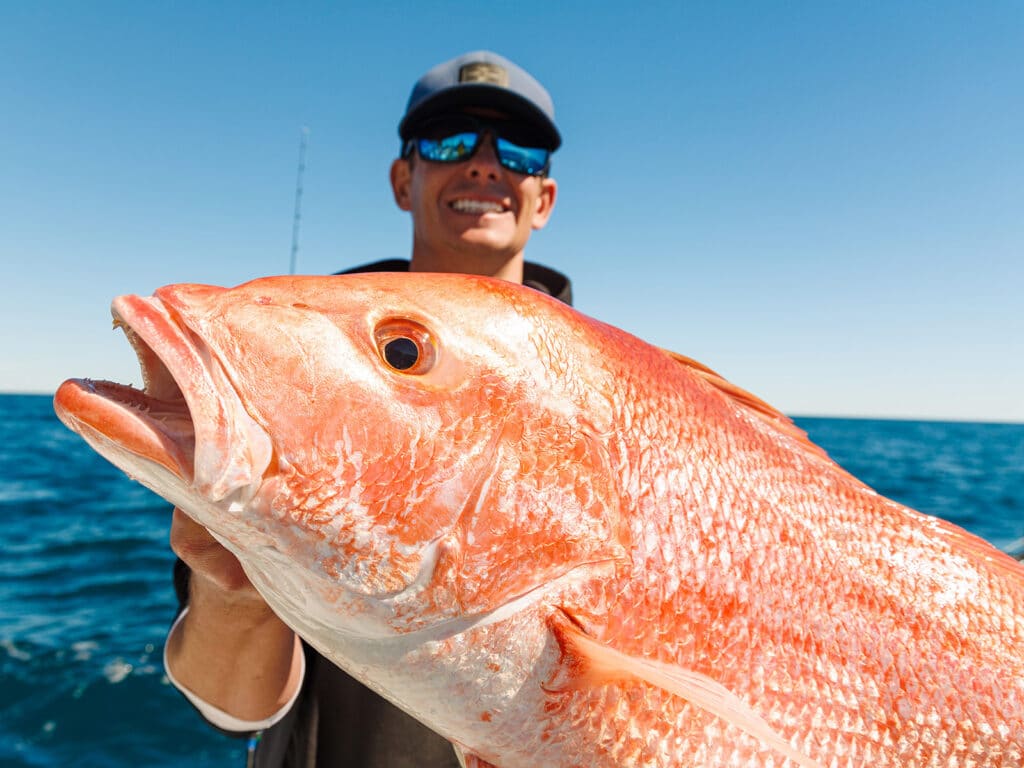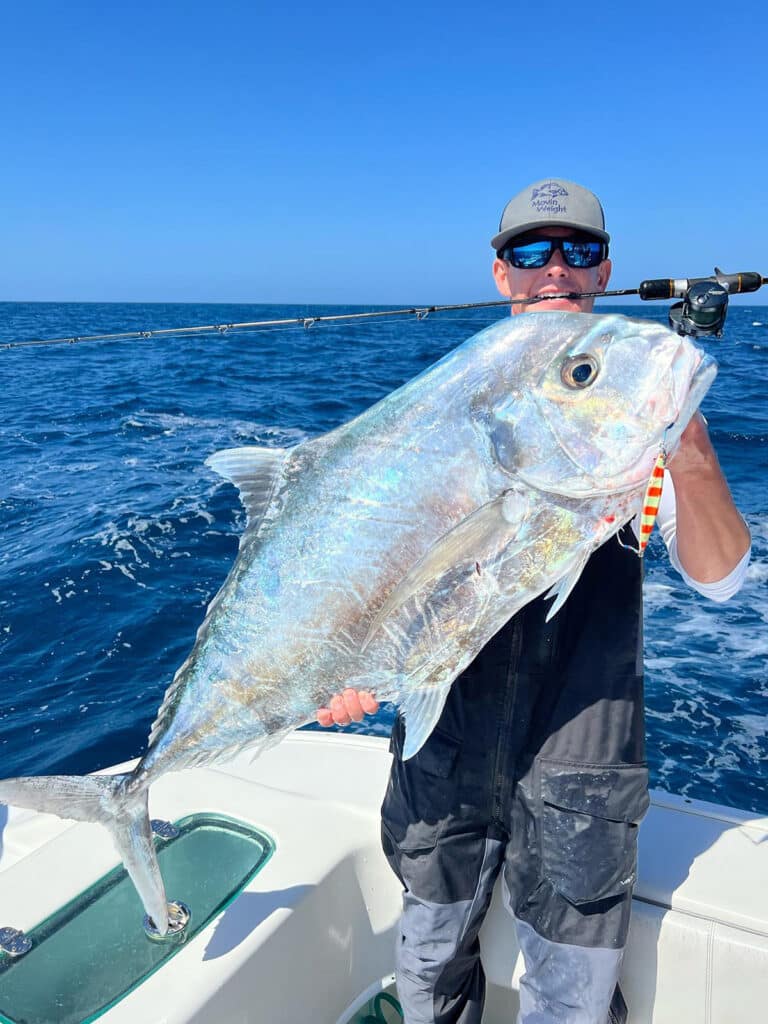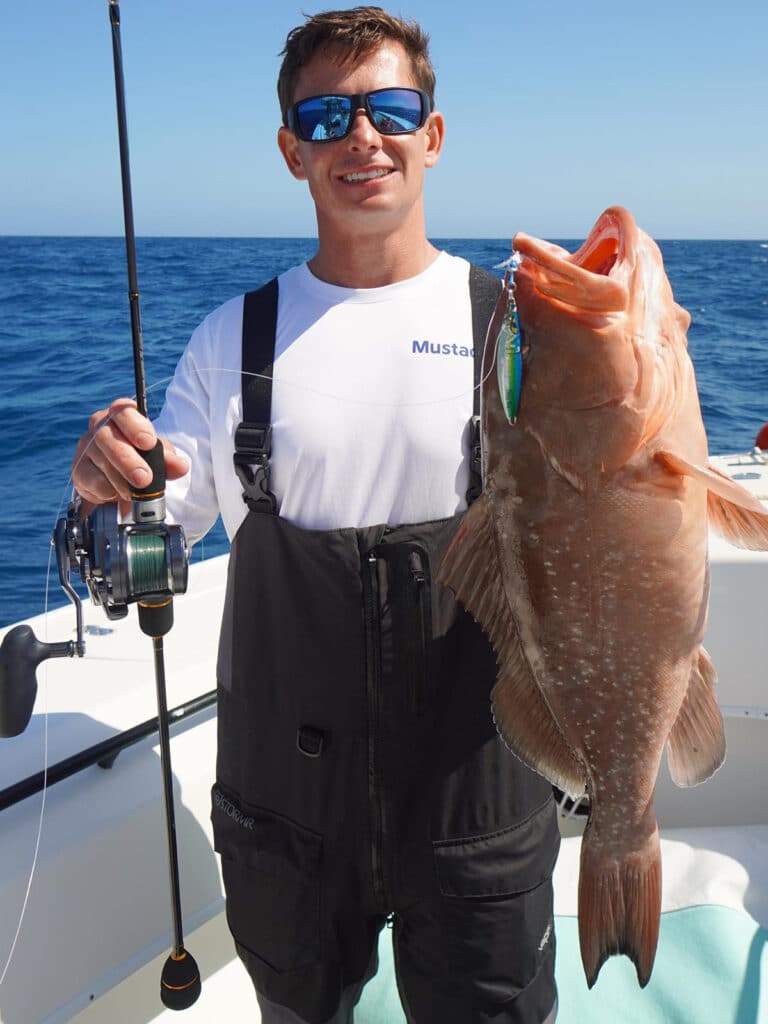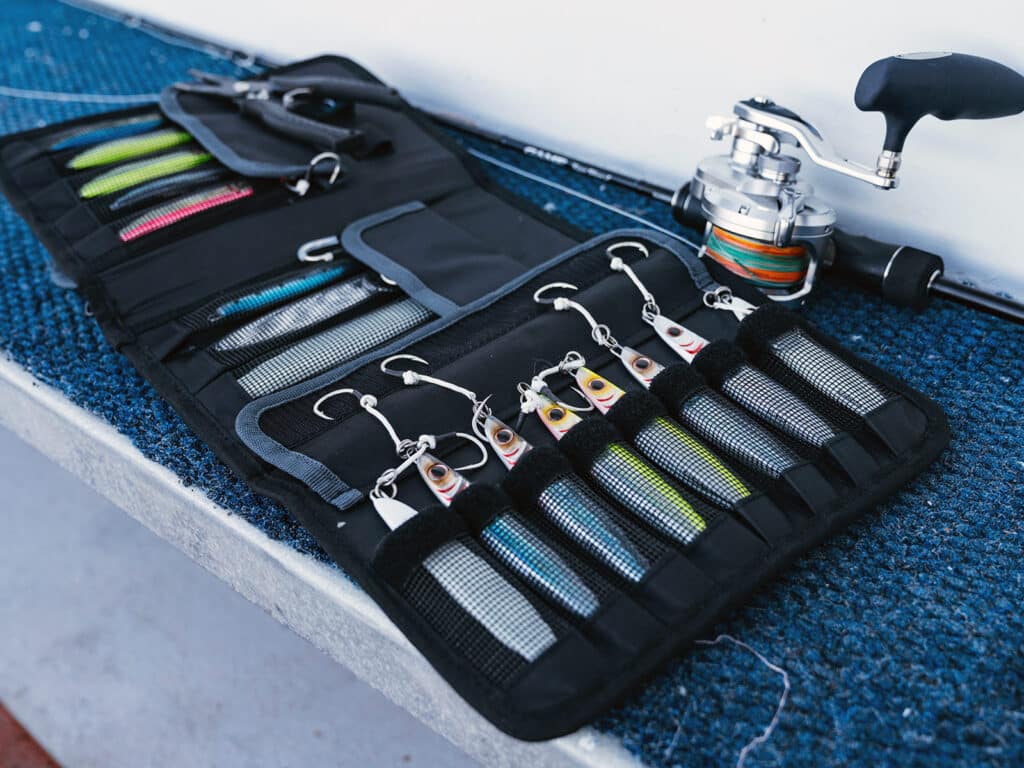
Jigging is one of my favorite ways to target hefty bottom fish. We’re talking grouper over 30 pounds, snapper larger than 20 pounds, African pompano, and plenty of others. With slow-pitch jigging taking the world by storm — and for good reason — I’ve been able to land some very large fish on surprisingly light gear. I’d like to share my experiences when it comes to tackling big fish on light tackle. Ideally, you can skip the learning curve and jump straight to choosing a great slow-pitch jigging tackle.
One Important Slow-Pitch Jigging Technique
Use slow-pitch techniques as the foundation for picking jigging tackle. Any type of jigging is most effective when the angler maintains a tight, vertical line angle. The more scope, or the greater the angle between the angler on the boat and the jig they’re working, the less action the jig will have. Secondly, a huge bow in the line reduces jig sensitivity. Anglers can’t feel the jig’s action with the added scope. They can quickly lose direct contact with their jig. And that leads to anglers trying to work their jigs with a huge bow in their line — which simply isn’t effective or productive. With a drifting boat, keeping your line tight to your jig takes some effort.
Best Slow Pitch Jigging Line

Braided fishing lines have come a long way in terms of breaking strength relative to line diameter. When jigging, you want to use the thinnest line diameter you can get away with, as this creates less drag through the water, greater sensitivity of the jig and rod working together, and ultimately results in a vertical line angle.
I choose anywhere from 15- to 40-pound braid (or PE line ratings of 0.8 to 2.5). Don’t focus heavily on the strength rating, as braided lines often snap at much heavier weights than what’s listed on the spool. The diameter of the line is the most important number to consider when choosing a line. And I’m almost always picking something between 0.15 and 2.5 mm. The deeper I’m jigging, the thinner the diameter line I use. And that’s for two reasons: less drag and increased line capacity. Sometimes I’ll drop as deep as 1,000 feet of water.
For depths under 300 feet of water, I recommend a 20- to 30-pound test (0.19- to 0.25-mm) braided line. For depths deeper than 300 feet, current becomes a major deciding factor. I have successfully dropped jigs in 800 feet of water with 20-pound-test line, but as soon as the current hits 2 knots, use 15-pound test and under — it makes a huge difference in fishing effectively. Unfortunately, there is no one size fits all for jigging, but I recommend owning two reels, one with 20- to 30-pound braided fishing line and another with 15-pound test.
Slow-Pitch Jigging Reels
Everyone has their favorite brand of reel. I have fished many of the major brands including Shimano Ocea jigger, Daiwa Saltiga, Jigging Master, Maxel and others. They all work and I suggest you fish the one that is most comfortable for you. Your price range is likely the most important consideration. Some features in specific reels really stand out. The auto engage function in the Shimano Ocea jigger is a benefit — an auto-clutch engages the reel out of free spool to react to quick bites. On Jigging Master reels the level-wind really helps with line management during the fight.
Top-of-the-line jigging reels definitely have better features in higher-priced models, but most jigging reels can get the job done. With that being said, when targeting bigger fish, I want to have higher top-end drag capacity. That’s when I’ll use my Jigging Master reels. On the other hand, with slow pitch jigging, the technique is all about finesse. It’s easy to argue drag is less important, as you’re really “easing” the fish up from the bottom. Find a reel that has the features you want and don’t get caught up with the branding.
Slow Pitch Jigging Rods

Jigging rods are primarily designed with one factor in mind, and that’s the size jig to use. I always want to work the smallest size jig I possibly can while maintaining a vertical line angle. The saying goes, “elephants eat peanuts,” and that holds true for jigs and big fish as well. I recommend these three rod types to cover the majority of scenarios:
- A 100- to 400-gram slow-pitch rod. You will probably use this rod 90 percent of the time
- A 400- to 1000-gram rod. This rod is used for heavy current conditions and dropping in deep water
- A high-speed jigging rod, rated for 100- to 300-gram jigs (conventional or spinning setup)
Jigging shouldn’t be overly complicated. You can keep adding rods to your arsenal that become more and more specific to the type of jig you’re working, although I don’t think it’s necessary.
Slow-Pitch Jigs

Metal jigs come in a variety of shapes, sizes and colors. I think anglers get way too caught up in their jig colors and styles. Those flashy, colorful jigs in a tackle shop are there to catch fishermen too.
There is something to be said about jig shape and overall shade of color. For example, a jig’s shape will determine how it moves through the water. A long, slender jig will have a fast fall and erratic side-to-side jerk when worked at high speeds. A short, stocky or flatter jig will have a noticeable wobble and slower action. Do both work? Yes. Find the one that is working that day and don’t overthink it.
This holds true for color as well. The only factors I consider for color are dark versus light, flash versus no flash, and ultraviolet glow. On overcast days or with murky waters, I’d focus on darker colored jigs. Fishing sunny days and clear waters, then I focus on light colors and jigs with reflective surfaces. Keep in mind, I’ve caught fish breaking the exact rules I just stated, so seriously don’t overthink it. The UV or glow jigs are important in deep-water conditions where squid are present; you’re mimicking a squid in pitch black waters.
Slow-Pitch Jigging is a Finesse Fight
I recently fished on a Salt Water Sportsman Adventures Gulf trip where I caught a 20-pound red snapper, 60-pound amberjack, and watched my fiancé Brook Crist land a 30-pound yellow-edge grouper. All these fish were caught on slow-pitch jigs, with relatively light-drag applications of about 12 pounds.
There are at least two common thoughts for fighting big fish. Here’s the one I follow. The harder you pull, the harder they pull. That leads to a greater likelihood they’ll break you off on structure or from tackle failure. The beauty of slow-pitch jigging lies in the finesse fighting style. It’s almost as if you’re giving them a gentle teeth-cleaning, slowly luring them to the surface. Who wants a harsh root canal?









